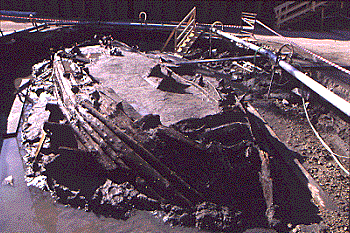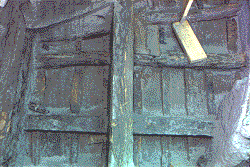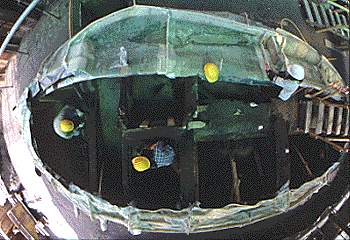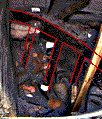

| |
| Ship D |
"A Cache of Vintage Ships" Volume 52 Number 4, July/August 1999 |
 |
| Ship D capsized before sinking; the dirt-filled area in the center represents a gash in its bottom. |
Ship D is the best preserved of the lot. Some 46 feet long and 20 feet wide, it was found capsized, its frame and deck in mint condition and its hull surviving except for a portion of the bottom. Material from the same levels suggests that the boat dates from sometime after the first decades of the second century A.D.
 |  |
| Timbers and planks of deck (left) are exceptionally well preserved, as is a hatchway (right) that gave access to the hold. |
As ARCHAEOLOGY reported in "Sunken Ships of Pisa," May/June 1999, several features of the hull suggested at first that it was a warship: the shallow draft, typical of ancient men-of-war; the shape of the prow, which could have carried a ram; and the presence of a platform extending from one gunwale, similar to platforms visible on ancient images of warships. But, says Casson, the shape and structure of the boat indicate that it is rather a work boat used for daily chores like carrying cargo between quays and large ships moored farther out in the harbor, or running errands up and down canals. Workboats had shallow drafts so they could negotiate small waterways. The ship's length-to-breadth ratio of two to one would be suitable for such craft, while war galleys normally clock in at ten to one. Likewise its simple construction, lacking proper framing and having only roughly finished timbers, is telltale.
 |
| Ship D has now been encased in a fiberglass shell, while excavators continue to work inside it. |
What is not clear is how the boat was propelled. Side platforms would make sense on craft that were poled rather than rowed or sailed, but a verdict will have to wait until the boat has been fully excavated and archaeologists can tell whether it had a mast, thole pins, and oarsmen's seats. The outside of the boat has been encased in fiberglass, allowing excavations to continue inside without risking collapse. Already archaeologists have exposed the beams and planks of the inverted deck and the walls of a hatchway through which the crew would have accessed the hold. In one place excavators kept digging for several feet beneath the boat, where they discovered the fragmentary remains of yet another vessel. After excavation of the interior is finished, the whole ship will be moved in one piece to the conservation lab. 
 | Fragments of another, as-yet unexcavated, vessel (outlined in red) have been found beneath ship D. |
Introduction | Ship A | Ship B | Ship C | Ship D | Other Ships | A New Museum?
© 1999 by the Archaeological Institute of America archive.archaeology.org/9907/etc/shipd.html |
Advertisement

Advertisement






